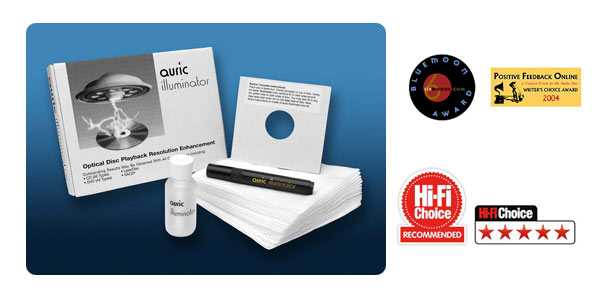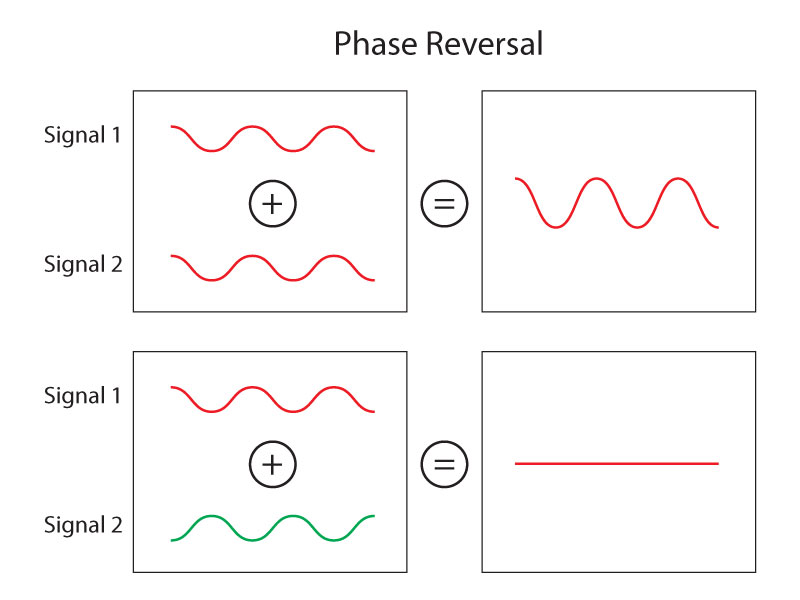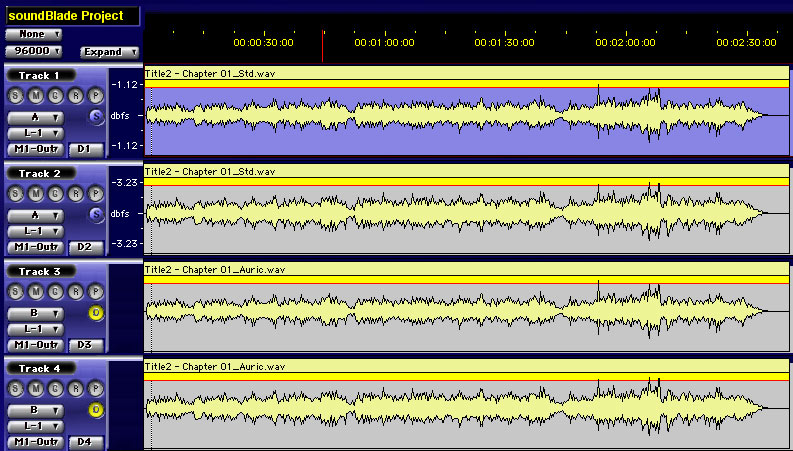Optical Disc Tweaks: The Test – Part II
If I slather a gel over the surface of an optical disc or coat the edges of that same disc with an opaque black marker will the reproduced sound of the treated disc be “enhanced” or even different than an untreated disc? That’s the question that confronts me. And so given the push back from the maker of the Essence-of-Music, $150 treatment package that is available to audiophile, I finally decided to put it to the test. Unfortunately, Dr. Robert Spence, the developer of the Essence product, was unwilling to send me one of his products for testing so I had to resort to a very similar and very positively reviewed product made by Audience. It is called the “Auric Illuminator” and it claims to enhance the fidelity and optical readability of the digital information encoded in the bumps on an optical disc. John McDonald and principal of Audience (who BTW makes very high quality cables and speakers…I have them in my studio!), sent me the Auric Illuminator a while back for my evaluation.
There are two steps involved with the Auric Illuminator (from their website):
“The first step reduces ambient light and infrared light in the disc material. The Auric Illuminator light absorbing pen is used to blacken the inside and outside edges of the CD. (The outside rim and the inside of the center hole). This improves the signal to noise ratio of the reflected signal allowing for more accurate timing of the retrieved data.
The second step involves the application of Auric Illuminator gel. This unique product improves the optics by allowing laser light to enter and leave the disc with less reflection or scattering. This allows the pickup to “see” a stronger, more sharply defined signal resulting in fewer data retrieval errors.”
This is not a cleaning process…which might be able to improve the readability of an older or scratched disc…the Auric and Essence products are for fidelity enhancement. In order to do that, they would have to alter the bitstream that is read by the optical pickup and that is ultimately reproduced by the DAC.
The Auric site explains how it does its magic:
“Auric Illuminator gel also lowers the disc surface electrical charge. The surface of an untreated disc will build up a static charge while spinning against the air. The static charge builds up until the voltage becomes quite high and then discharges into the air or surrounding surfaces. The charge/discharge cycle causes the disc to microscopically tilt or wobble…[you can go to Auric Illuminator to read the rest].
The explanation pseudoscience, technical nonsense. If all of that bad stuff is happening inside your optical pickup, then the bits and timing that a good quality DAC gets will contain so many errors that the sound will suffer. However, if the bits from an untreated disc and the bits from a treated disc turn out to be identical, what does that say about the “necessity” of treating your disc with the Auric gel? It means that there is nothing to be gained by spending $50 or $150 on surface treatments (or any other inside the disc drawer audiophile tweaks).]
So here’s what I did. I took two brand new copies of my High Resolution Audio Experience DVD-Audio sampler and ripped the bits from a treated and untreated disc to my laptop hard drive using DVD Audio Extractor. I pulled the Mosaic track by Laurence Juber, which was recorded at 96 kHz/24-bits and mixed in stereo (this track won the CEA Demmy Award for “Best High Resolution Track” in 2002).
Figure 1 – An illustration showing phase cancellation when equal and opposite phase signals are added together…the result is nothing [Click to enlarge]
I imported both WAV files into my Sonic Soundblade mastering application (which is THE standard for digital mastering…av very professional tool) and routed both stereo programs to a single digital output bus. They played together perfectly. Then I reversed the phase on the Auric treated soundfile and hit the play button again. The output bus completely disappeared! I listened to the entire 4 minutes listening at a loud level in headphones for any signal…there was nothing.
Figure 2 – The waveforms of the standard and Auric streams in Sonic Soundblade [Click to enlarge].
These means that the two datastreams were absolutely identical. Any two identical signals will completely cancel each other when one is phase reversed. So how can the developers of Auric or the similar Essence product…or anyone who writes glowing reviews about these products…say that the treatments do anything? The string of ones and zeros from both discs were moved from the disc to the hard drive and both files contained exactly the same string of bits. The Benchmark DAC2 played the same string of bits back…and the fidelity of the recording was not modified or enhanced at all.
So in my opinion, I’ve shown unambiguously that the Auric product is bunk…and I suspect that the results would be the same for the Essence product and any other disc treatment (de-ionizers, etc) accessories.
I know that some of you will continue to believe and provide testimonials about your experiences or the experiences of your wives. The facts say otherwise. As one reader wrote and told me…it’s a debate that can’t be won. It’s an issue of faith vs. reason. I choose reason.




Mark,
An even faster and easier test: Once you’ve ripped both disks to WAV – the exact bits from each playback, listed as a string of ones and zeros – run a “file compare” utility – like the DOS command fc – specifying the two files by name.
This is easiest if you put them into the same directory (folder) and open your command line window with that as the current directory, in which case all you have to type is:
fc file1 file2
[If you have any spaces in the names, enclose each file’s name in quote marks – DOS is like that (Yes, it is).]
It’ll either come back with a list of differences or the flat statement “No differences encountered.”
There can’t be any arguing with that – no “your amplifier [or your ear] wasn’t sensitive enough” The strings of bits are either the same or they’re not.
Phil
Phil…thanks for the suggestion. I’m actually a Mac guy although we do have a bunch of PCs around. The point is that the data streams are the same from the treated vs. untreated disc. How can anyone argue otherwise? But I’m sure they will.
Oh – and do this with a CD, not a DVD-Audio disk. Why? Because the DVD standard has better error-correction than CD, and they’re advertising this as a product to improve CD playback – not those newfangled DVDs!.
Don’t leave them anything to use to confuse those susceptible to Jedi mind tricks!
[“Those aren’t the disks you’re listening to. Move along.”]
Unfortunately, AIX Records doesn’t make CDs. The results would be the same. They actually say that these products will enhance the video on your television monitor too. I have to get back to my regularly scheduled programming.
Dr. Mark:
I like to frame it as “belief vs. real-world/hard evidence”
This, I’m afraid, will never change!
Absolutely great work! Keep it up!
Barry Santini
Mark,
I would load the two files into Audition and mix the two files 180 degrees out of phase. That should in theory result in nothing but zeros. In my mind, that would be a way for Mac guys to prove it with no ears involved.
Blaine
Blaine…that’s exactly what I did except I trust my Sonic Soundblade software (same guys that produce Amarra) ore than Audition.
Hi Mark, although I am on your side, I don’t think your test (which I greatly enjoyed reading about) would satisfy the tweaky audiophile.
Here’s why: you didn’t compare analog outputs or jitter levels. Part of your article mentioned the claim of a beneficial effect on jitter. Well, you didn’t measure jitter, yet jitter is known to be an audible artefact (although the audibility threshold level is fiercely debated, and I think it is very high, but others argue it is very low). And the pro-tweak argument doesn’t stop there. The logic says that the laser drive may be having to work harder before-tweak, so its control circuitry is working harder, even if it is picking up every bit of data correctly. Now, sure, your top end pro gear may have totally isolated and regulated power supplies, but not every playback player is so endowed, in fact cheaper models may have one power supply unit for analog and digital circuitry, so now we have a potential flow-on effect from the digital circuit to the analog circuits of the player. So now we have two systems (one with tweak and one without) that are both picking up every bit correctly, but the systems are behaving differently. And that difference could be audible.
I rethink that logic is quite reasonable, don’t you? Even though I strongly disagree that the difference *would* be audible, the pure logic of the argument I think is okay.
So, I think the correct test is to play the treated and untreated disc on a basic cheap player through its *analog* outputs, digitise the two, phase reverse one, and try to minimise the sum output by cancellation, then play that back and listen through headphones.
How about giving it a go? I would really like to see that. Or maybe you think there is a better way?
Grant, you make some interesting points. And I guess I should continue doing some variations of the test to confirm some additional conditions. As to the jitter being a factor, that’s a non starter. A rip pulls the data from the disc out of real time. The Benchmark DAC plays back the file with a completely new clock so there would be no timing differences between the treated and untreated discs.
The whole issue of the analog outputs vs. a data rip is interesting and worthy of a new test. I suspect that the tweak advocates will always find a reason to doubt these findings but it is fun to do them.
Grant,
Your method of testing to prove or disprove the product has a built in problem that may well show a difference in the summed, phase flipped signal…
Variances in ESR between the two players would definitely give you visible differences, whether you hear them in the nulled or near nulled sum.
Even placing a film cap and an electrolytic cap respectively in the L&R output coupling caps would give you easily measurable variances.
There are systems that can log the rate and amount of error correction during read and convert, and this might be the data to compare.
The data would not be exact correction, bit for bit because the disk does not spin flawlessly, but the rate of correction averaged should be either insignificant when averaged, or prominent when compared between treated and not.
Personally, I think these kinds of things sound better the more expensive they are… If you catch my drift?
Sincerely,
John Chase
Mark,
After interacting with many, many “audiophiles” over the last 30 years I believe I know why they insist that these hocus pocus products work. Coming from the High End LP background, where you could achieve large quality increases by twisting here and there, they felt cheated out of the possibility to do so when the CD players came along. CD players are just some square cases and adding a weight or wood or rubber won’t do anything. So they chose the only thing they could influence, the “audiophiles” believe that some magic has to improve the sound of some plastic carrier of data. If you would tell them: ” This is it, live with it, none you can do about it!” They would probably all admit themselves to the mental institution because of broken hearts.
Thx for yet another clearing up of the wodner products out there.
Very good points…now that we’ve moved into the realm of digital information, there are audiophiles, reviewers and others that insist on keeping their analog thinking alive.
Could it be this line of thinking that sells “Magic Mahjongg” pieces for high dollars to, “open up” the sound of components?
Having spent many years behind the console, I love nice gear, twiddling controls, I’ll admit to being a gadget freak, but it is also great to just close your eyes and listen to the magic of the music.
Amen.
Your methodology involves ripping to computer, and comparing the results and they are identical. I agree with the logic. It’s what I would have expected from my own experience.
There’s another consideration though. When reading/playing a spinning disc, there is error correction going on, “on the fly” so to speak. Ripping and playing back from computer eliminates this live correction at the spinning player.
Can I ask you to listen to the 2 discs being played live through your system, and for you to comment on whether here is any difference in sound quality?
Thanks Steve